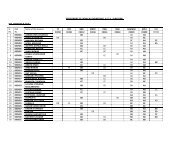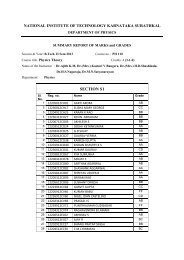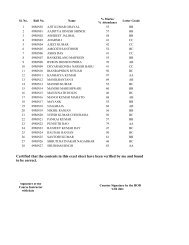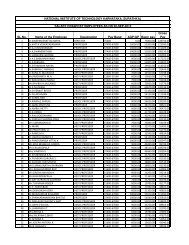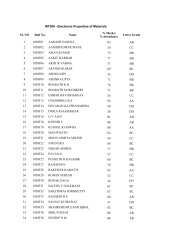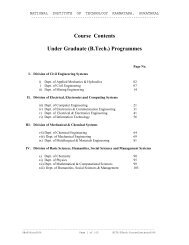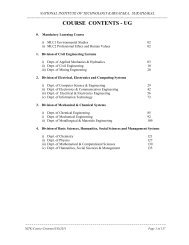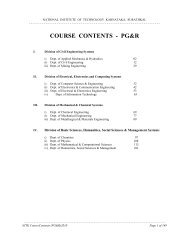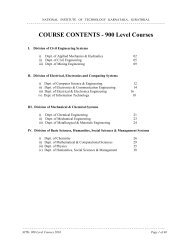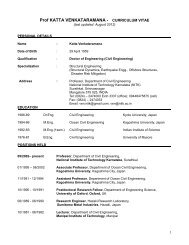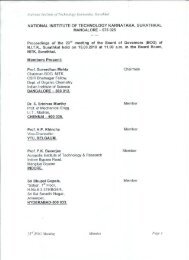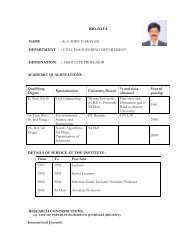course contents - ug - National Institute of Technology Karnataka
course contents - ug - National Institute of Technology Karnataka
course contents - ug - National Institute of Technology Karnataka
Create successful ePaper yourself
Turn your PDF publications into a flip-book with our unique Google optimized e-Paper software.
NATIONAL INSTITUTE OF TECHNOLOGY KARNATAKA, SURATHAKAL<br />
------------------------------------------------------------------------------------------------------------------<br />
V.Gerasimov & A. Monakhov, Nuclear Engineering Materials, Mir Publishers, Moskow, 1983.<br />
D.S.Clark & W.R Varney, Physical Metallurgy for engineers, East West Press, New Delhi, 1987<br />
C.M.Srivatsava & C.Srinivasan, Science <strong>of</strong> engineering Materials, 1997, New Age International.<br />
MT409 FRACTURE OF ENGINEERING MATERIALS (3-0-0) 3<br />
Failure and their causes - techniques <strong>of</strong> failure analysis, conventional design concepts, inadequacies <strong>of</strong><br />
conventional design, mechanics <strong>of</strong> fracture, theoretical cohesive strength, Griffith theory <strong>of</strong> fracture,<br />
Irwin - Orowan modification, concepts <strong>of</strong> G and R, relation between G and rate <strong>of</strong> change <strong>of</strong> compliance,<br />
crack tip stress fields, stress intensity factors, relation between G and K, fracture to<strong>ug</strong>hness: determination<br />
<strong>of</strong> fracture to<strong>ug</strong>hness, ASTM standards; crack tip plasticity, plastic enclaves and their effect on energy<br />
release rate, concept <strong>of</strong> plastic zone criterion, R curve concept, J Integral, COD criterion, brittle and<br />
ductile fractures, fatigue crack growth and fracture mechanics, stress corrosion cracking, liquid metal<br />
embrittlement, hydrogen embrittlement, microscopic aspects <strong>of</strong> cleavage crack propagation, plastic<br />
relaxation at crack tip, nucleation <strong>of</strong> cleavage cracks by plastic deformation, crystallographic mechanism,<br />
initial growth and propagation, ductile - brittle transition; designing and testing for fracture resistance,<br />
principles <strong>of</strong> fracture safe design, testing procedure, designing steels for fracture resistance, improved<br />
to<strong>ug</strong>hness in ceramics, composites, case studies in failure analysis.<br />
D.Broek, Elementary Engineering Fracture Mechanics, Marinus Nijh<strong>of</strong>f, Dordredet, 1986.<br />
J.F.Knott, Fundamentals <strong>of</strong> Fracture Mechanics, Butterworths 1973.<br />
S.Teteleman & A.J.McEvily, Fracture <strong>of</strong> Structural Materials, John Wiley and Sons, 1961.<br />
MT440 PRACTICAL TRAINING/EDUCATION TOUR 2<br />
This <strong>course</strong> is a 2 credit <strong>course</strong>. A student may complete the training or educational tour before the<br />
beginning <strong>of</strong> 7 th semester (or as stipulated by DUGC) and register for it in 7 th Semester. The duration and<br />
the details shall be decided by the faculty advisor, with approval from DUGC.<br />
MT447 METAL FINISHING LAB (0-0-2) 1<br />
Cleaning base metal: (Steel specimens) buffing, brushing, polishing, degreasing, acid dip - water wash,<br />
common metal plating: Zn, Ni, Cd, Cr, Cu - acid baths, Zn, Cd, Cu - cyanide baths, post plating, drying,<br />
passivity, lacquering, phosphating, test on deposit: corrosion resistance test - by salt spray chamber,<br />
hardness, ductility by bending test, photo micrographs. .<br />
MT448 FOUNDRY TECHNOLOGY LAB (0-0-3) 2<br />
Sand testing: moisture content, clay content, permeability, sieve analysis <strong>of</strong> base sand, strength properties<br />
<strong>of</strong> molding sand, shatter index, mold hardness; clay testing: gelling index, gelling time, pH measurement,<br />
acid demand value, design <strong>of</strong> casting: selection <strong>of</strong> parting line, design <strong>of</strong> patterns, full mold process, CO2<br />
molds, melting and pouring <strong>of</strong> aluminium alloy, defect analysis; computer aided designs.<br />
MT449 MAJOR PROJECT – I (0-0-6) 4<br />
MT450 ADVANCED ENGINEERING MATERIALS (3-0-0) 3 PREREQ: MT 400<br />
Metals for high temperature service, Ti and Zr alloys, Ni and Co based super alloys, rapid solidification,<br />
metallic glasses, production, properties and applications, liquid crystals: production, properties and<br />
applications, composite materials, mechanics <strong>of</strong> composite materials, dispersion strengthening, metal<br />
matrix composites, special steels, maraging steels, trip steels, patenting, interstitial free steels, smart<br />
materials, shape memory effect, principles, pseudoelasticity, applications, nano technology, nano<br />
materials.<br />
R. E. Reed Hill & Reza Abbaschian, Physical Metallurgy Principles, 3 rd Edition, 1994<br />
PWS Publishers USA.<br />
W. E. Smith Structure & Properties <strong>of</strong> Engineering Alloys McGraw Hill, 1993<br />
F.L. Matthews & R. D. Rawlings, Composite Materials Engg. & Science, 1994<br />
---------------------------------------------------------------------<br />
NITK-Course Contents(UG)2010 Page 115 <strong>of</strong> 134



